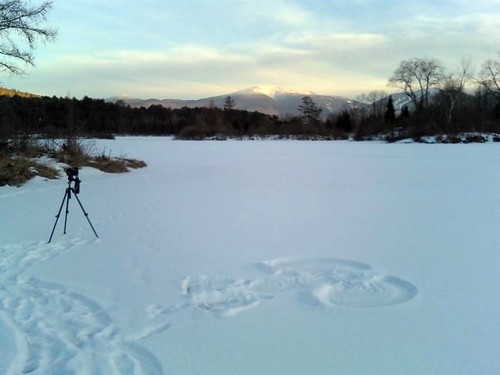Assignment: Mount Washington!

Observers repair instruments on the tower on New England's highest peak...
While on school vacation this week, I’ve been fortunate to do some assignment work for the Mount Washington Observatory. The weather conditions were perfect yesterday, including light winds, undercast and heavy rime accumulations.
I won’t be able to post a full report of this and other vacation week travels for a bit, but you can read about the assignment shoot at the Mount Washington Observatory website.
How to shoot a fox…
I would like to thank all of the followers of my photography and this blog for the great comments, questions and correspondence that I received in response to my series with the foxes at Carter Notch this past weekend. One question that I received a few times is HOW?! And not just how did I stumble across the foxes, but how I actually took the shot. Well, here goes.
There are a few places in the White Mountains that are known to attract foxes. The summit of Mount Washington, a few of the AMC Huts, the Cog Base Station all have fairly consistent resident populations. The foxes in these locations are fairly tolerant of humans, as part of their diets there are enhanced in three likely ways. First off, these foxes do feed directly on dropped scraps, inadvertent or otherwise, but I do hope it’s mainly inadvertent. Secondly, crumbs and scraps attract rodent populations that feed the foxes, and thirdly, the heat shelter of the building naturally invites more rodents. Working with these tolerant populations is helpful, as though they are still wild and skittish, they are also curious, and you can usually get fairly close.
This round of shots was made possible when a student of mine on the hike let me know that the foxes were had dug up some discarded (not by our group) fruit loops outside of the bunk houses. The kids were on the porch taking pictures themselves, and I began sneaking around the side of the bunkhouse. My sneaking methods is a cross between a crawl and slither in very slight movements.
The camera had been set for my landscape shooting, and needed adjustment. I knew that a fast shutter speed would be necessary to capture the images hand-held without any motion blur. I ripped off my trusty filters, leaving them in the snow, dialed up the ISO to 400, and put the camera on burst mode, so I can fire off more than one shot per push of the trigger. Next I put the camera on aperture priority, and locked it wide open (F/6.3 on my Sigma 18-200mm hiking lens). This allowed for shutter speeds of around 1/1000 of a second.
Once the camera was set, it was all about position, background and composition. I tried to maneuver myself so that the fox was between me and a good background. This fine subject allowed me to capture him for about 10 minutes, at distances as close as about 20-25 feet. The session ended when he came in too close, I made a movement too sudden, and off he went.
In that time, I fired off about 50 frames. Some, the focus was off, some the composition was off and many more had awkward poses or looks. I think about four of the fifty are usable. Below is one more of the usable examples, and it needed some cropping to square to balance out an otherwise off composition.
Hope y’all find this helpful, and I’m always happy to answer questions.
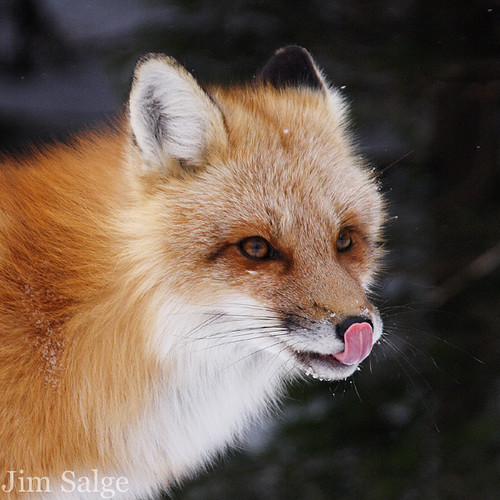
Jim Salge Photography - Funny Fox
Carter Notch Trip – Full Recap!
This weekend, I led a trip to the AMC’s Carter Notch Hut via Pinkham Notch for an overnight stay. The conditions were perfect for winter hiking: hard packed snow with minimal ice, seasonably mild temperatures in the teens and 20s, light wind and an occasional gently falling snow. The first day went just as smoothly as it could go!
Sunday morning I awoke in the notch at a bit before 6AM to capture the sunrise, and crawled out of my bed to find a fox on the front porch. Continued wandering found limited light, but much of the fine feelings of waking up in a place that inspires awe with its beauty. When I returned to the bunkhouses, the students were excited that the fox was still around. He was curious, inquisitive and though a bit skittish, was clearly tolerant of our presence. I managed to get a few nice sets of shots off before he moved on.
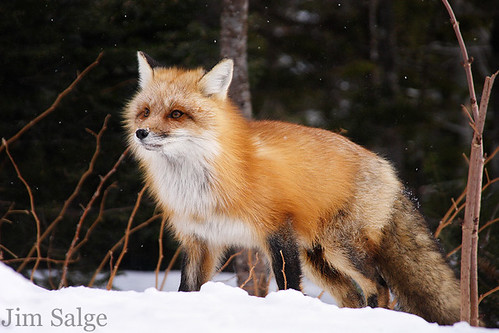
Jim Salge Photography - Carter Notch Fox II
On the trip down, we took a break next to the Nineteen Mile Brook. With the absence of recent snowfall, all of the detail and beauty that is usually concealed in a frozen stream was on display. I concentrated on some areas where open water was surrounded by a frozen landscape, and was most pleased by this shot about a mile from the bottom.
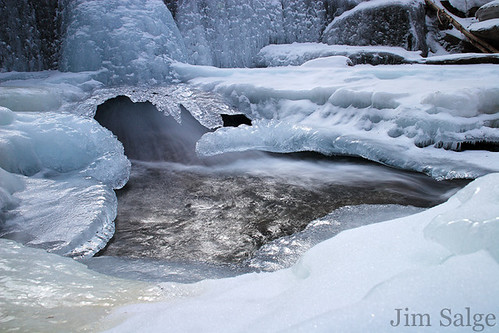
Jim Salge Photography - Icy Falls and Flow
This shot would have capped off a perfect trip, but unfortunately, there was a cruel Valentine’s surprise waiting for us at the bottom. Overnight, vandals had smashed my and my co-leaders cars in the lot, and made off with some of our electronics.

As teachers, we like to make every moment a teachable moment, but to our students who lost their cell phones, ipods and innocent sense of security that morning, there was little we could we could do to console them after their return to the oft cruel, civilized world. The cold drive home didn’t help either…
This morning, I have a new window, a new checking account, and have a new Wolverine portable storage devise on order. A minor setback, a major inconvenience, and a lesson learned…but this one experience certainly cannot dampen my love of the Whites!
Carter Notch Trip Update…
I’m back from Carter Notch Hut…it was a great night up there, and I got a few usuable pics for sure…including this fine fox below. I’ll edit more up here during the week.
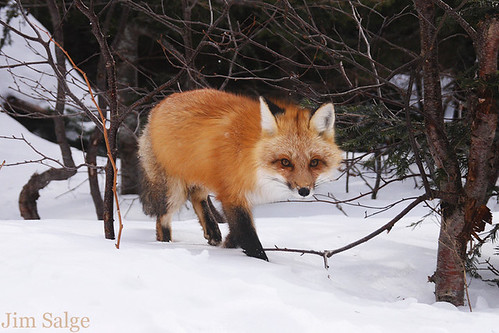
Red Fox at Carter Notch
Unfortunately it wasn’t all good news though, as my car, and a friend’s car got smashed into while at the hut. The left most of my stuff, but did take a hard-drive I upload pictures from the road on…and I don’t have a window…so that’s fun!
I’ll post more pics and a complete tale soon!
Controlling the Light…
The greatest challenge that any nature photographer faces is trying to capture what they see in front of them in a medium that has its limitations. And since I began posting my photography on the Internet, one of the most common questions I get is how do I get the range of light and color in the pictures that I capture. I’d like to take a bit to offer some insight this morning…
The first reason that my photographs are so full of color is that I limit my shooting to scenes that lend themselves to great color, and great color renditions. For example, last Saturday night in Sugar Hill, NH, I was fortunate enough to witness a great display of alpenglow falling upon the Franconia Ridge. The light was fantastic, but brief. There are less than 20 minutes in time between the two scenes below. Making sure that you are in the right place and the right time is the most critical part of landscape nature photography.
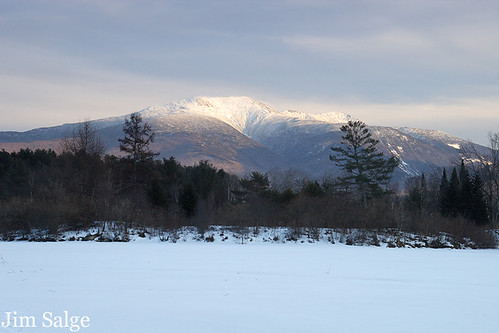
And…less than 20 minutes later…
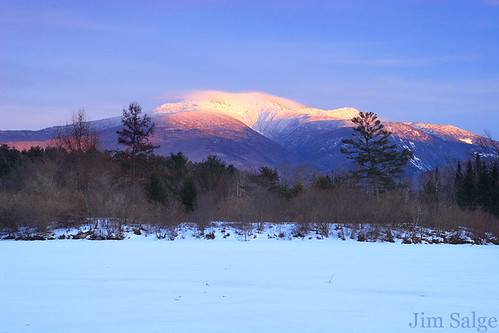
However, capturing rich, dynamic and saturated images goes well beyond pointing the camera at good light. The problem with this is that the camera sensor can only capture about 7 stops of light. Essentially, what this means is that the human eye is able to see a much much greater latitude of light, from shadows to highlights, than the camera. This is why when you take a shot of a sunset, often times everything else is in silhouette. While this can be a nice creative touch to a photograph, my goal is always to capture a scene as the eye sees it, and therefore I employ some classic tools for landscape photography.
There are three lens filters that I carry with me at all times to control the light entering my camera. Each provides a different piece in the puzzle that when put together properly, can capture the true beauty of the scene in front of you.
These include:
- The Polarizer. This filter allows you to control contrast, cut glare, darken skies, and increase saturation with the spin of the front element of your lens. If you’ve ever worn a pair of polarized sunglasses, you know the effect. This filter almost never leaves my lens…
- The Neutral Density filter. This filter is just a piece of gray glass that is designed to lengthen the amount of time that the shutter exposes the scene by cutting the amount of light reaching the sensor. Classically used to make river and stream shots silky smooth, I find that long exposures allow for much more color intensity. You get all of the color and luminosity of a scene without the intensity of the light.
- The Graduated Neutral Density filter. Pictured below, this half gray, half clear filter can balance out the difference in light between bright skies and shadowed foreground. I carry five of these with me at all times, ranging from light gray to nearly black, and believe that the use of these define my style of landscape photography.
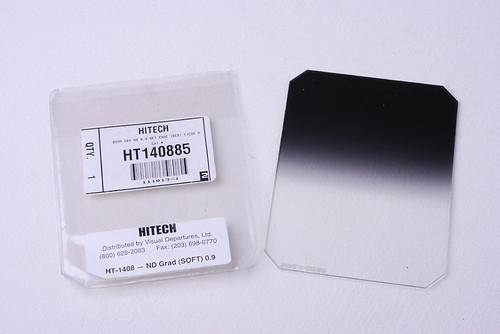
It’s important to note that this style often leads to sunrise and sunset exposure times that range from 2 to 20 seconds long. A rock solid tripod is therefore essential to capturing dramatic and dynamic light.
It is also important to note that this stacking of filters can easily be taken too far, and it’s important to learn how each tool works, how they compliment each other, and when it all becomes too much. For example, about a half an hour after sunrise on the big lake Sunday morning, I over polarized and increased the exposure too long. The scene lacks contrast, and the color rendition is far too blue to be natural. This highlights the need to practice, know the light, and know how to use your tools to capture it.

The risks of too many filters...not ideal!
My traditional solution surprises many in this world of technological integration into photography. I try to minimize the use of Photoshop to post-process the images I capture. While I admit, this is an important step, for me, the ‘pre-process’ is much more important, and honestly enjoyable. To me, there is nothing better than being immersed in magic light, stacking the filters, looking down, and seeing on the LCD that you’ve nailed the shot!
I hope that this answers many of your questions, and that this sheds some light on my technique and style. Please feel free to leave comments and questions below!
Whatever the Weather…
When I think winter shots in New England, I always think fresh snowfall, dramatic skies, and muted light on scenes of classic New England culture and charm. While these things aren’t always possible to capture, I often have to remind myself that there’s usually some scene worth shooting, whatever the weather that you are presented with.
Rainfall, try waterfalls. High winds, try some long exposure. Fog, moody forest shots. Overcast, how about macro. Recently, we’ve had an unusual set of challenges when shooting. Despite the cold, we’ve not seen a fresh snowfall in New England in some time. So this weekend, I focused on ice…and we have lots of that.
Streams, usually pillowed with snow, show the exquisite detail of their frozen flow.
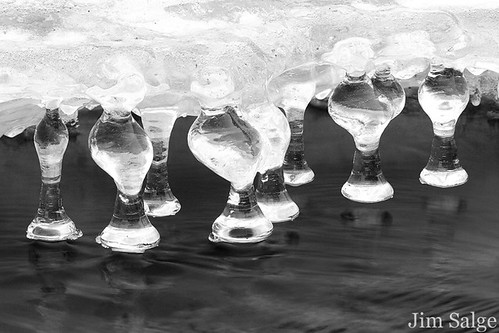
Lakes freeze more uniformly, but have their own personality traits in how they show the stress and strain of the expansion of frozen water. Squam was a plate of glass, while Winnipesaukee, larger and more prone to wind, and more expanse to compress, was a bit more cracked and rutted.
Sunday morning after shooting the mountains I caught a great sunrise on the big lake. Focusing on the foreground, I found this ice fishing hole a nice anchor for the scene. It was covered in three inches of new ice, and the total ice thickness is probably between 18”-24”. Impressive.
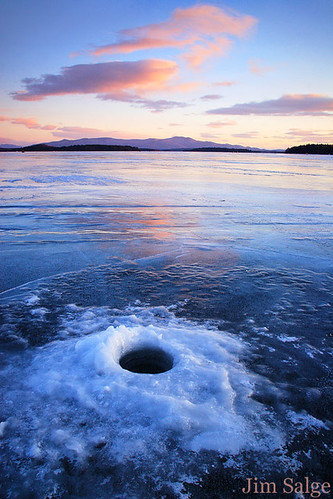
I can’t say I’ve seen the ice on lakes this reflective for this long, this late in winter, but if I were a photographer in New England with time this week, I’d be shooting the ice every sunrise and sunset. I’ll try to get back there myself.
And maybe it’ll snow sometime…
Franconia for sunset…
Alpenglow is truly magical light.
As the sun sets, the rays of light get longer and longer, filtering through more and more atmosphere. And the color gets softer and softer. It is often rendered most intense as it falls upon snow capped mountains after the valleys have gone dim. Moments of beauty and warmth before a long, cold winters night.
Northern New England missed out on ‘Snowtorious BIG’ ‘walloping’ the Mid-Atlantic states, but extended shield of high clouds from the storm, exiting at sunset provided the perfect window for strong alpenglow yesterday. After a great meet-up shooting ice and snow in Plymouth, NH with the NH Flickr Group, I headed north to the town of Franconia. I was hoping to shoot from Bald Mountain at sunset, but a bit of a cold kept me grounded, so I scouted roadside shots.
Coffin Pond is a roadside beauty in Sugar Hill. I’ve a few shots in my collection from there, and also have fond memories of my first summer in NH fishing from it’s shore. The view in summer is sub-par, but with the addition of ice, you can find some great views of the Franconia Ridge from the back side.
Waiting for the sunset, I was kept occupied by following the tale of a fox and a mouse imprinted in the shoreline of pond. I ate a few highbush cranberries frozen in the brush. I listened to the silence of the northern forest. And I had a little fun with the fine sugar snow:
The magic light came suddenly, and strongly, as the whole ridge seemed to be ablaze. Pictures can’t capture the intensity of the color and light on the mountain as the rest of the world falls to shadow…

And then it was gone. Not the light, but the mountain. Clouds came in and capped the view…and off I ran. There was a vantage I’d scouted a while back with a great view to Washington. Hope was that they were clear…and with a long lens to isolate the scene, I capped of a great, frantic half hour of shooting in Franconia.

I’ll be posting a few blogs this week on the meetup, of this morning on Lake Winnie, and of some technique for capturing great alpenglow…but this cold is requiring me to take a nap!
Thanks for reading!
Winter Rut
Well,
No way to sugar coat it…it’s pretty ugly down here in Southern NH. Half bare ground, worn, weathered snow…not much inspiration. We were hammered by rain a week ago, and have had little fresh snow since. I’d usually go to the coast, but we’re in a low tide at sunrise cycle, not good for pictures. And add to that, I’ve been car-less for the past week (catalytic converter), and it’s limited any opportunities I would have otherwise taken. Simply, I’m in a rut!!!
This morning, I went to one of my favorite local lakes to catch the full moon set. The scene was beautiful, and the air crisp and quiet. It was great to be out. But photographically, I have little to share for my efforts and joy in being out. Clear skies and a minimal frost limited any reflected light for the foreground, and I experienced the most problem with light in much of winter…strong contrast.
Snow is bright, trees are dark. You therefore have to choose which to expose for, and often times, shadows are simply too deep to resurrect any detail from. I came a way with a passable shot, but certainly not one for the portfolio…
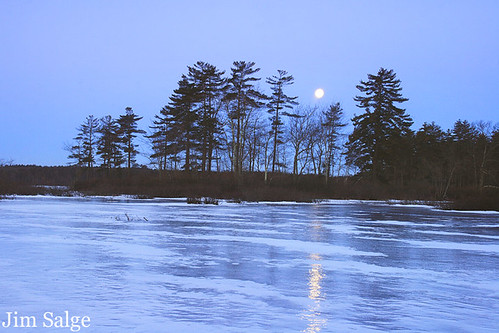
To get out of my rut…I have plans for the next few weekends that will take me to some more grander landscape. I hope to shoot the Plymouth area with friends next weekend, and then hike to Carter Notch the following weekend. Then it’s school vacation, which has a full itin of shots around the Presis! Hopefully, there’ll be much more to share with everyone soon!
Until then, hope for some snow!!!
